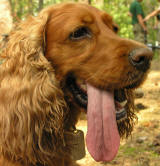What is normal?
All dogs bite. Nipping and play
biting are
normal
canine communication.
Nipping starts when
puppies explore the world with
their mouths and
teeth. However, nips may also
result from fear. Some puppies nip during play or play
solicitation (asking for play by
nipping).
|
Never hit
your dog or cause fear or pain
during play sessions to prevent
your dog learning to bite from
fear or anger.
|
Puppies
learn early how to
fight, play and escape danger.
By just a few months of age,
puppies
begin to
practice rough play with each
other.
In
nature, puppies play in order to
exercise and build muscle,
nervous system, and respiratory
organs. Therefore, the goal is
to teach appropriate play not to
stop play altogether.
A
angry or scared dog may bite and
then run to hide. An angry or highly
aroused dog may bite continuously
until the human retreats.
Why is it important to teach
gentle play behaviors?
Many dog bites go
unreported. People tend to
forget that domestic dogs are
animals that need instruction on
how to be gentle with humans.
|
Allowing a puppy to play
bite or scratch your hands or
legs may lead to aggressive
adult dog play. |
Dog
Play Body Language
 Dogs
use a variety of body language
signals to display playfulness.
An individual dog may show any
combination of these play signals:
Dogs
use a variety of body language
signals to display playfulness.
An individual dog may show any
combination of these play signals:
-
Play Bow
- Slapping both front legs
on the ground with the rump
up in the air.
-
Exaggerated Looking
Away - Focusing
on you while pretending to
look away
-
Pawing With Front Paw
- This is the solicitation
gesture; roughly means "Please."
-
Prancing ZIG And Zag Leaps -
Lots of energy and joy.
-
Chase Behavior
- Canine equivalent of starting
a tag game
-
Play Facial Expression
- Distinct once you start
looking for it
-
Frequent Role
Reversal -
Pushy
dogs acting submissive to
signal non-threatening play
|
Your dog needs daily interactive
play sessions for healthy
physical and mental development
and aging. |
What to do

Play
with your adult dog
daily for at least 15 minutes
to allow natural
behaviors, healthy exercise and
quality time with you. Keep play
interesting by varying the game
and toy every few minutes. Toss in
an occasional treat to make the
game more fun.
Your goal is a tired, panting
dog.